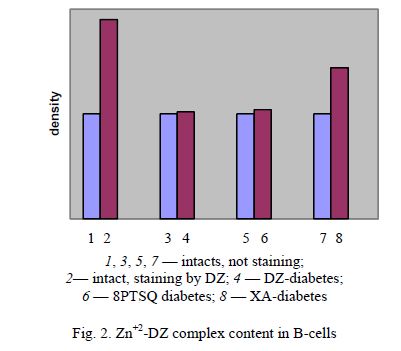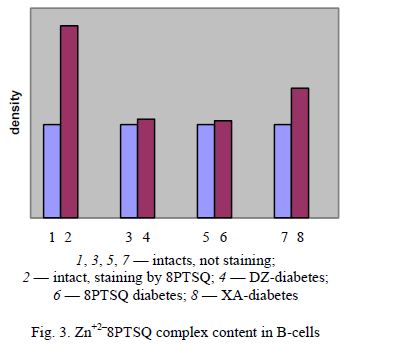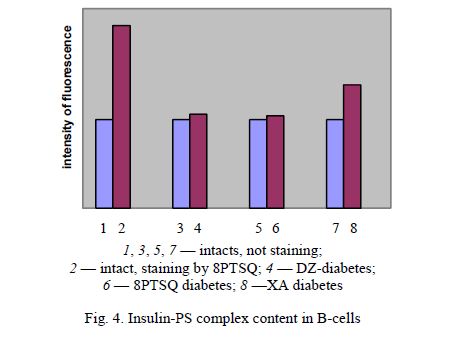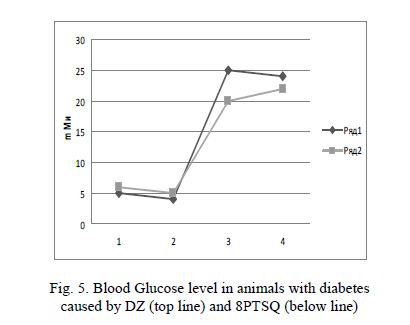Authors showed that interaction of diabetogenic chelators as Diphenylthiocarbazone and formed in Human some derivatives of 8-oxyquinolin with Zn2+-ions contained in B-cells result destruction of cells and develop- ing of 1 type diabetes. Preliminary elimination of Zn2+ — ion- from cells or blocking ions by not diabetogenic chelators protect B-cells of interaction with diabetogenic substances and as result — of developing of diabetes.
Background. It is known that diabetogenic derivatives of 8-aren(sulphonylamino)quinolin as 8-me- tan(sulphonylamino)quinolin [8MSQ], 8-bensol(sulphonylamino)quinolin [8BSQ], 8-para(toluenesulphonyl- amino)quinolin [8PTSQ], 4,8-(dihydroxyquinolin)-2-carboxylic acid (Xanturenic Acid, XA) as diphenylthio- carbazone (Dithizon) [DZ] possess high chemical affinity for Zn+2-ions and in vitro formed color complexes as Zn+2-chelator [1, 2]. 8MSQ and 8TSQ formed fluorescent yellow and green complexes with Zn+2-ions vis- ible using fluorescent microscopy and Dithizone formed red DZ-Zn+2-ions complex visible using dark mi- croscopy. Maximum of absorbance of Zn+2-DZ complex on spectrum of absorbance correspond for 580 nm [3]. 8PTSQ is very sensitive for revealing of Zn+2-ions in solutions contained minimal concentrations as 10–7–10–8 of Zn+2-ions and is used for color revealing of its in solutions. Diabetogenic properties of all the- se substances were established previously and determined by ability to form complex salt with Zn+2-ions in cytoplasm of B-cells that result necrosis and death of cells within short time [4, 5]. Using of transmission electron microscopy it was confirmed [6] that death of B-cells determinad by destruction of B-granules of B- cells, contained maximal concentrations of Zn+2-ions. Injection 35–50 mg per kg body weight of these sub- stances result developing of type 1 diabetes in animals within 1–3 days and accompanied by destruction of B-cells, marked increasing of blood glucose level until 20–25 mM as by developing of evident histological changes in pancreatic islets typical for type 1 diabetes [2, 3, 6].
Aim of work: investigate interaction of Zn+2-ions contained in B-cells with 8PTSQ and DZ in pancreas tissue of intact animals as in Zn+2-ions in animals with type 1 diabetes, past elimination of ions from B-cells and past preliminary concurent binding of ions with chemicals possess more high affinity for Zn+2-ions.
Methods. 14 Rabbits 2450–2850 g, 26 Wistar Rats 165–176 g and 8 Mices 33–38 g were used.
- Experiences with Dithizon and Preparing of Dithizon solution: 30 mg of Dithizon, (SIGMA, USA) +10 ml bidistillate+0.2 ml 25 % NH4OH 10 min mixing on temperature +70º at Celsium. Solution was injected intravenously to Rabbits and to Mices 46–48,6 mg/kg. Diabetes caused by XA was produced by containing of Rats on diet stimulated endogene synthesis of XA in animals and Human [3,7].
- Experiences with Preparing of 8PTSQ solution: 25 mg of 8PTSQ (Inst. High Pure Chemi- cals, Moscow) was dissolved in 65 % Ethanol on +70º Celsium and injected to Rabbits 35,5–38,8 mg/kg [8].
- Experiences with Na salt of Diethyldithiocarbamic Acid [DDCA], a blockator of Zn+2-ions in B-cells [8]. DDCA formed not toxic for B-cells complex with Zn+2-ions and not result developing of experi- mental diabetes [9]. Contrary, binding of Zn+2-ions by DDCA, injected in doses as 500–1000 mg per kg body weight in 95 % animals protect B-cells of death and of developing of diabetes caused by DZ and diabetogenic derivatives of 8-oxyquinolin for 12–24 h [5]. We used water solution of DDCA (MERCK, Germany) which was injected to Rabbits for 42,3–46,2 mg/kg.
- Experiences with removing of Zn+2-ions from B-cells by Glibenclamide [GB] and with extraction of complex Zn+2–DZ from B-cells. Mobilisation of Zn+2-ions from B-cells protect cells of death caused by chelators [10, 11]. Suspension of GB in starch was used for per oral injections of GB 1,2 mg/kg daily within 3 days. 6 Rats were used. Frozen sections of Rat’s Pancreas 4 mcm were investigated 10 min past injection on dark microscopy. Intensity of staining was measured by photometer. 2nd part of pancreas tissue was fixed in Ethanol 70 %; paraffin sections of tissue were stained by 0,4 % acetone solution of 8PTSQ [6, 12, 13, 14] and investigated on fluorescent microscope. 3rd part of Pancreas tissue was fixed in Bouin 24 h. Staining technologies: staining of paraffin sections of pancreas 4 mcm by Aldehyde-fucshine (Avocado Chemical Company, USA), and by Diethylpseudoisocyanine (SERVA Finebiochemica, Germany) [10, 11].
Results
Intact animals. Reaction with Dithizon. Intensive staining of cytoplasm of B-cells by red granules of DZ-Zn+2 complex. Histotopography: density of staining is 3–3,5 times more high around blood vessel compara- tively with other parts of B-cell’s cytoplasm [Fig. 1: 1.1–1.3] that showed more high concentration as of insulin as Zn+2-ions around wall of blood vessels. Results obtained by DZ-method (Fig. 2) as by aldehyde-fuchsine technic are more precise comparatively with fluorescent pseudoisocyanine (Fig. 4) and 8PTSQ (Fig. 3) technics that maybe explained by interference of fluorescence from zones of B-cells contained maximal amount of insu- lin to other parts of cytoplasm of B-cells. Reaction with 8PTSQ for Zn+2-ions: intensive green fluorescence of complex Zn+2-ions-8PTSQ, negative reaction past injection of 50 mg/kg of DDCA [Fig. 1: 1.9] and partial de- composition of complex Zn+2-ions-DDCA 6h past injection [Fig. 1: 1.8, 1.9]. Extraction of DZ-Zn+2 complex from B-cells result negative reaction for Zn+2-ions by both methods [Fig. 1: 1.7–1.9].
Animals with type 1 Diabetes. It is known that as Dithizone as multiple diabetogenic derivatives of 8- oxyqui- nolin caused developing of heavy diabetes 1 day past administration. Blood Glucose level first a few hours is decreased as result of releasing a large amount of insulin from destroyed B-cells and 24h later is in- creased till 15–25 mM (Fig. 5). Contrary, in animals with XA-diabetes blood Glucose level slowly increased y till 9,0–12,0 mM (Fig. 6). Histostructure of pancreatic islets of animals with DZ-diabetes and 8PTSQ- diabetes: necrosis and destruction of B-cells as disappearing of Zn+2-ions and deposited insulin from cyto- plasm of cells [Fig. 1 1.13–1.15; Table 1]. In opposite, not so marked decrease amount of insulin as of Zn+2- ions con- tent in B-cells of pancreas tissue of animals with XA-diabetes were observed [Fig. 1: 1.4; 1.5; Ta- ble 1].
Discussion
It is known that B-cells of Pancreas tissue of Human, Rabbits, Dogs, Mice, Rats, Kats contained a large amount of Zn+2-ions which formed into cytoplasm of B-cells deposited form of insulin located in B-granules. Elimination of insulin from cells accompanied by decomposition of Zn+2-Insulin complex [15]. Deposited insulin concentrated on apical part of B-cells contacted with islet’s blood vessels. Thus, B-cells formed around blood vessels a ring of cells, contained maximal concentrations of deposited insulin (Fig. 1: 1.4) well visible on sections stained by aldehyde-fuchsine and immunohistochemical technics. Vital interaction of Zn+2-ions in B-cells with DZ result forming granules of Zn+2-DZ located on apical part of cells too. Previous- ly on parallel sections of pancreas tissue it was showed identical localization as of deposited insulin as of Zn+2-DZ complex in cytoplasm of B-cells. It was evidently showed that diabetes caused by DZ is developed in animals in case if past injection of DZ complex Zn+2-DZ formed in B-cells only and never developed if this red complex is not formed due to any causes. What part of amount of Zn+2-ions in cytoplasm of B-cells reacted with DZ past injection of diabetogenic dose? Our previous works [2, 5] showed that past extraction from B-cells of Zn+2-DZ complex by CHCl3 we found a complete absence of Zn+2-ions in B-cells (Fig. 1: 1.13–1.15) as of deposited insulin. Thus, these data showed that all amount of Zn+2-ions contained in cyto- plasm of B-cells reacted with DZ past one injection and complete disappearing of Zn+2-ions from B-cells is accompanied by complete disappearing of insulin from cells too. This result demonstrate that histochemical reaction with DZ revealed not only Zn+2-ions in cytoplasm of B-cells but deposited insulin too.

Fig. 1. Histotopography
In Fig. 1:
- Frozen section of intact Rabbit’s Dark microscopy: A-cells on periphery of islet, B-cells in central part; ×280;
- Frozen section of Rabbit’s Pancreas past injection of 48,9 mg/kg of DZ. Dark microscopy: red granules of Zn+2– DZ complex in B-cells; ×280;
- Frozen section of Mice Pancreas past injection of 50,8 mg/kg of DZ: granules of Zn+2–DZ complex around blood vessels; ×280;
- Section of intact Rat’s Staining by Aldehyde-fucshine: violet color of B-cells determined by large amount of deposited insulin in B-cells. Histostructure without changes; ×280;
- Section of Pancreas of Rat’s with diabetes caused by Aldehyde-fucshine: necrosis and destruction of B-cells, decrease of insulin content; ×280;
- Section of Pancreas of Rat’s with diabetes caused by XA. Fluorescent staining of Zn+2-ions: decrease of concen- tration of Zn+2-ions in B-cells; ×140;
- Section of intact Pancreas of mice. Fluorescent staining of Zn+2-ions. High concentration of Zn+2-ions in B-cells;×140;
- Section of Pancreas of Rabbit’s past injection of DDNa. 250 mg/kg, Fluorescent staining of Zn+2-ions: decrease of intensity of fluorescence as result of binding of Zn+2-ions in B-cells by DDNa; ×140;
- Section of Pancreas of Rat with XA-diabetes. Negative reaction for Zn+2-ions in B-cells as result of destruction cells and disappearing of ions; ×140;
- Frozen section of Rabbit’s Pancreas past injection of 51,3 mg/kg of DZ. Dark microscopy: granules of Zn+2-DZ complex in B-cells; ×280;
- Same Frozen section of Rabbit’s Pancreas past extraction of Zn+2-DZ complex from B-cells by chloroform. Dark microscopy: granules of Zn+2-DZ complex disappeared (extracted) from B-cells; ×280;
- Same Frozen section of Rabbit’s Pancreas past injection: Zn+2-reaction with 8PTSQ is negative, fluorescent mi- croscopy; ×140;
- Frozen section of Rabbit’s Pancreas past injection of 47,6 mg/kg of DZ. Dark microscopy: granules of Zn+2-DZ complex in B-cells; ×280;
- Frozen section of Rabbit’s Pancreas with diabetes caused by DZ. Dark microscopy: absence of Granules of Zn+2- DZ complex in B-cells as result of destruction of B-cells; ×280;
- Same islet. Negative fluorescent reaction for Zn+2-ions as result of death of B-cells an disappearing of Zn+2-ions; fluorescent microscopy; ×140.
T a b l e 1
Zn+2-ions and Insulin content in B-cells stained by Dithizon, 8PTSQ and Diethylpseudoisocyanine


Fig. 2. Zn+2-DZ complex content in B-cells

Fig. 3. Zn+2–8PTSQ complex content in B-cells


Fig. 5. Blood Glucose level in animals with diabetes caused by DZ (top line) and 8PTSQ (below line)

Fig. 6. Blood Glucose level in animals with diabetes caused by XA
Experiences with 8PTSQ. 8PTSQ is high specific fluorescent reagent for revealing of minimal concen- trations of Zn+2-ions in solutions as 10–7–10–8. This same time due to ability to form in B-cells of toxic com- plex as Zn+2-ions-8PTSQ this reagent is possess diabetogenic properties as other derivatives of 8-oxyquinolin and is able in doses as 30–35 mg per kg to provoke developing of heavy diabetes in 100 % of animals within 1–2 days past injection. For staining of frozen sections of pancreas tissue Zn+2-ions in cytoplasm of B-cells we used a few drops of 0,4 % 8PTSQ acetone solution for 1 min. We observed Zn+2-ions as intensive green fluorescence in cytoplasm of B-cells of intact animals and as absence of fluorescence in animals with diabe- tes Zn+2-ions (Fig. 1: 1.6, 1.7, 1.9).
Despite of fact that usually there are parallelism of content Zn+2-ions and insulin in B-cells, is not pos- sible to use results of reaction with 8PTSQ for estimate amount of insulin in B-cells as by DZ-technic be- cause 8PTSQ as chemical reagent revealed pure Zn+2-ions in B-cells but not complex Zn+2-ions-chelator. In added, 8PTSQ-technic is valid for revealing of Zn+2-ions in B-cells as free ions or ions formed complex with insulin. In case if insulin is connected with DZ, or with derivatives of 8-oxyquinolin reaction with 8PTSQ be negative as in section of pancreas of diabetic animals despite normal amount of Zn+2-ions n cells. Extraction of complex Zn+2-DZ from B-cells (Fig. 1: 1.11) accompanied by disappearing of Zn+2 from B-cells. Same result we obtained in animals with diabetes: destruction of B-cells result disappearing of Zn+2 from cells and accompanied by negative reaction for Zn+2 in cells (Fig. 1: 1.13–1.15). Analogical negative result we showed in animals past injection of derivatives of Diethyldithiocarbamic acid (DDCA) which possess more high af- finity for Zn+2 in compared with DZ and 8PTSQ [16]. As result DDCA remove DZ and 8PTSQ from complexes Zn+2-DZ and Zn+2–8PTSQ with forming not visible and not toxic for B-cells complex Zn+2-DDCA (Fig. 1: 1.9).
In conclusions, using noted above histochemical methods is possible to estimate as total amount of Zn+2-ions as color complexes Zn+2-insulin Zn+2-DZ and Zn+2–8PTSQ in cytoplasm of B-cells. In diabetic animals negative reaction for Zn+2-ions demonstrate absence of ions as result of destruction and death of B-cells. Negative reaction in health animals showed absence of Zn+2-ions in B-cells as result of elimina- tion [16] caused by some drugs. This conditions in B-cells not able to make deposited form of insulin. Nega- tive reaction in health animals caused by not long time binding of Zn+2-ions by not diabetogenic chemicals demonstrate not absence of Zn+2-ions in B-cells but presence in not visible complexes with chemicals. But in majority cases negative histochemical results revealing of Zn+2-ions in B-cells are as sign of destruction and death of B-cells.
Acknowlegement
Authors are thankful to Prof. K.-D.Kohnert, Karlsburg, Germany for material and financial supporting of work, to Dr.R.Schilly, Boehringer Mannheim, Wien, Austria for pure substance Glibenclamide, Dr. E.Horn, SERVA, Germany, for Diethylpseudoisocyanine, to Prof. B.Tuch, Dr.L.Williams, Sydney, Aus- tralia, Prof. F.Wohlrab, Leipzig, GERMANY and Prof. G.Wolters, Groningen, Netherlands for histochemical technologies and to Dr. R.Thunberg, Uppsala, Sweden for reagents. Work was supported by grants of Institute of Diabetes «Gerhardt Katsch», Germany, University of Greifswald, Germany, Boehringer Mannheim GmbH, Germany, by financial supporting of Prof. J.Turtle, a vice-president of IDF, Sydney, Aus- tralia and Dr. H.Ritzel, Frankfurt, Germany.
References
- Okamoto K. Diabetes Mellitus: Theory and Practice, McGraw-Hill, New York, 1970, p. 230–255.
- Lazaris Ja.А., Мeiramov G.G. Problem of endocrinology, Моscow, 1974, 5, p. 90–94.
- Lazaris Ja.А., Dziomoko V.М., Кrasavin I.А. Problem endocrinology, Мoscow, 1968, 4, p. 107–111.
- Meyramov G.G., Meyramova A.G. Diabetes, 2002, 51, 6, p. 591–592.
- Meyramova A.G. Problem of endocrinology, Моscow, 2003, 49, 2, p. 8–16.
- Meyramov G.G., Тruchanov N.I. Problem of endocrinology, Моscow, 1975, 6, p. 92–95. 7 Kotake Y. Chem., 1957, 3, p. 432–446.
- Meyramov G.G., Meyramova A.G., Mindubaeva F.A., Kikimbaeva A.A. Diabetes, 2012, 60, 6, p. 719–720.
- Meyramov G.G., Kikimbaeva A.A., Meyramova A.G. Acta Diabetologica, 2003, Springer, 40, 1, p. 208–209.
- Kvistberg D., Lester G., Lasarov A. Journal Histochem. and Cytochem, 1966, 14, p. 609–611.
- Coalson R.E. Stain Technol., 1966, 2, p. 121–129.
- Meyramov G.G., Kikimbaeva A.A., Meyramova A.G. Acta Diabetologica, 2005, Springer, 42, 1, p.
- Meyramov G.G., Meyramova A.G.Diabetes, 1991, 40, 6, p.
- Bozhevolnov E.А., Serebrjakova G.V. Chemical reactants and preparations, Мoscow, 1961, p. 36–42.
- Meyramov G.G., Akmaev I.G., Andreeva A.P. Canadian Journal of Physiology and Pharmacology, 1994, 72, p.
- Meyramov G.G., Kikimbaeva A.A., Meyramova A.G. Acta Diabetologica, 2003, Springer, 40, 1, p.